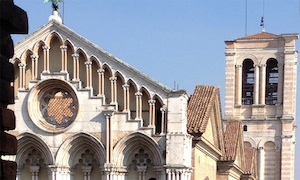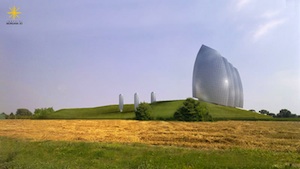Geothermal and waste energy sources
Φεράρα, City of the Renaissance, and its Po Delta, with an area of 46,712 έχει, was inscribed on the World Heritage List in 1995. The humanist concept of the ‘ideal city’ came to life here in the neighbourhoods built from 1492 onwards by Biagio Rossetti according to the new principles of perspective. The completion of this project marked the birth of modern town planning and influenced its subsequent development. Today Ferrara continues in this creative spirit in such fields as energy.
Ferrara is one of the most sustainable cities of Italy and environmental issues are seriously taken into account by the Municipality. It subscribed the Aalborg chart in 1996 και 1998 ξεκίνησε τη Local Agenda 21 διαδικασία. It has also been awarded by Legambiente (η ιταλική περιβαλλοντική υπηρεσία) ως η καλύτερη φιλική προς το περιβάλλον πόλη 2001. The municipality is member of several Italian and European networks of sustainable cities (ICLEI, BigNet, and Car Free Cities) and is signatory of EU’s Covenant of Mayors.
The Geothermal Project
The use of geothermal energy as energy source starts with its discovery in 1956, during explorations for oil reservoirs at a depth of 1,000 m, 4 χλμ ΒΔ από το κέντρο της Ferrara. At that time the well was abandoned and only after the energy crisis of the 70’s it was taken again into account, to utilize this important energy source.
Recent geo-structural and geothermal investigations carried out by HERA Group (Energy Resources Environment Holdings) in collaboration with the University of Ferrara and the Emilia-Romagna Region, confirm the presence of geothermal reservoirs in the east part of Ferrara. Three hydrothermal systems have been identified. Each reservoir can be considered hydraulically separated from the others by aquitards that prevent significant leakages.
At the beginning of the 80’s, the Municipality of Ferrara developed a Geothermal Project in order to exploit this resource as a primary source for an urban heating system and to reduce, in a solid way, the environmental impact created by the traditional energy sources (coke, oil and methane gas, etc…).
Αρχικά, Το γεωθερμικό ρευστό (ζεστό νερό, ca 100°C) αντλείται από τα βάθη της 1,000 μ στην επιφάνεια; τότε το ζεστό νερό μεταφέρει θερμική ενέργεια στο σύστημα θέρμανσης. Τελικά, έχει εισαχθεί εκ νέου στο υπέδαφος, προκειμένου να διασφαλιστεί η γεωτεχνική σταθερότητα.
Η κατασκευή του ξεκίνησε 1987 και 1990 τα πρώτα κτίρια συνδέθηκαν με το δίκτυο τηλεθέρμανσης. Σε 1993 η μονάδα ΣΗΘ για την θερμο-καταστροφή των στερεών αποβλήτων χτίστηκε, ενώ ένα δεύτερο και άνοιξε το 1995. Σε 1999 ένα turbo εναλλάκτη που τροφοδοτείται με τον ατμό που παράγεται από τη μονάδα ΣΗΘ εγκαταστάθηκε. At the end of 2010 the installed geothermal power was about 23 MWt.
Ολοκληρωμένο Σύστημα Ενέργειας
Τώρα, το δίκτυο σε Φεράρα τροφοδοτείται με το λεγόμενο «ενεργειακό σύστημα", because the energy from the Waste Treatment Plant was added to the geothermal source. Αυτό το σύστημα έχει περισσότερα περιβαλλοντικά και οικονομικά οφέλη από την παραδοσιακή, διότι σας επιτρέπει να έχετε σημαντική εξοικονόμηση κόστους και τη μείωση των εκπομπών CO2.
The system incorporates geothermal sources, CHP (combined heat and power) units installed in the solid waste processing plants, together with boilers running on biogas and used as backup systems. The urban heating network supplies the equivalent of 22,000 housing units, mostly in private and public buildings.
But the future is more promising. The proposed new Renewable Energy Hub will allow increasing this figure to 37,000 housing units, meaning that the district heating would cover the 40% of households. Another new development is that solar thermal will be incorporated to geothermal, with the capacity to convert solar energy into thermal energy for heating with a power of 1 MWt.
The energy mix will reach 90% of renewables. With the new Hub, 56.4% of the energy in the grid will come from geothermal sources, 34.3% from the Cassana incinerator, exploiting energy from waste and agricultural biomass, 0.3% from solar thermal, and only 9% from natural gas, the only non-renewable source.
Lessons learned and replicability
The District Heating System of Ferrara represents one of the most important examples of ‘Integrated Energy System’ that will be further increased by the future development. Λόγω της υψηλής ενεργειακής του απόδοσης το σύστημα πιστεύεται ότι είναι ιδιαίτερα σκόπιμο και μπορούν να μεταφερθούν, αν κάποιο θέμα μπορεί να σχετίζεται με το απαιτούμενο μέγεθος των κατασκευών, σχετίζονται με την αγορά, και οικονομικούς και τεχνικούς λόγους.


















